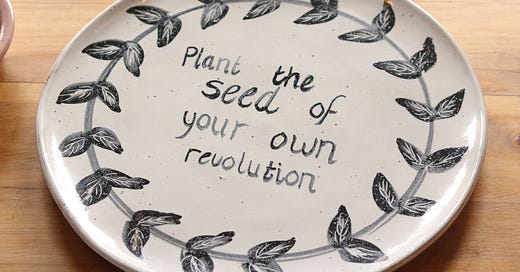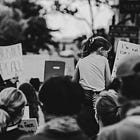In Monday’s Solicited Advice column, we shared some ways to get involved in organizing and advocacy while disabled — especially when you’re unable to be present in person. One of the options we mentioned was participating in boycotts and not crossing picket lines. But boycotts aren’t always accessible either. So, how can we navigate that tension?
A migraine backstory
I live with chronic migraine, which is clinically defined as at least 15 days a month where you experience headache or migraine, and at least eight days a month where headaches include migraine features such as aura or assorted GI symptoms. Both of these things must happen for at least three months to receive a diagnosis of chronic migraine.
For most of my life, I’ve had daily migraine symptoms. My most common migraine features, in addition to the physical pain, are light sensitivity (daily), nausea (multiple days per week), and aphasia (at least a few times a month). In most cases, attacks last several days, and one attack bleeds into another. I finally received a diagnosis of chronic migraine in 2009, after an attack came on so suddenly during a gym session that the trainer sent me home. Because we didn’t realize what was happening, I got in the car and started driving. I made it about a quarter mile before it got so bad that I couldn’t see properly. I pulled into a parking lot and was in and out of consciousness for several hours.
After that incident, I tried different prescription medications. None of them helped, in part because I hadn’t been tracking my symptoms well enough to recognize when an attack was coming — and because, again, my attacks bleed into one another — and so I didn’t take the abortive meds soon enough.
By 2015, I realized that Coke (the soda, c’mon) helped manage an attack. Then, in 2018, I started working with a doctor who convinced me to stop drinking it. For more than two years, I didn’t have any soda and limited my caffeine intake to one cup of coffee in the morning. Not only did it have zero impact on my other conditions, lab work, or weight as that doctor thought it would, my migraine frequency skyrocketed.
In 2020, I had fired that doctor and started drinking Coke again. By the end of 2022, in combination with other measures, my providers and I had determined two to three cans per day was the sweet spot for migraine prevention. I was no longer simply managing attacks — this combination of measures meant I was preventing some attacks from happening in the first place. The frequency was cut by at least half and the severity was significantly decreased.
Yet still, several medical professionals tried to talk me out of drinking Coke, in part due to the sugar content. Three cans of Coke (39 grams each) equals 117 grams of sugar each day. That’s double the recommended amount, and I also have PCOS, non-diabetic insulin resistance, and hypothyroidism which means I need to be even more careful with sugar. Sigh. A few doctors suggested I try switching to Diet Coke, which has aspartame — a migraine trigger for me that can also cause rashes, which I learned the hard way as a kid picking sweetener packets based on their colorfulness. 🙃 But I tried it anyway. It didn’t work.
Ultimately, I looked at all of the factors with two of the doctors I worked most closely with in 2023 and again in 2024, and we determined that while drinking Coke doesn’t sound great, the sugar content was not negatively impacting my actual health (other conditions, lab work, vitals, etc.) and had no impact on my weight either, as it stayed stable during that two-year period when I stopped drinking it, and every other time I stopped. The only actual impact we could find was a positive: It helped manage my migraine attacks. In 2024, I realized a new negative — I don’t enjoy the taste after the first few sips of the first can 😩 but it was still helping, and that won out.
To boycott or not to boycott
There are several companies that give me the ick just hearing their name, because we have evidence of how awful their business practices are to the planet and to their workers. Coke is one of those companies for me. And I’ve always felt guilty drinking it, because drinking it means someone has paid for it, and money supports their business practices. So I’m no stranger to the internal debate of “Is me feeling better worth XYZ?” and “OK, but if I don’t do what I can to feel better, I’m not helping either??”
If you’re thinking, “But hey, Jess, there’s no ethical consumption under capitalism!” — I see you. And/also, I do still interrogate my personal practices because some things are less harmful than others.
This came to a head for me, again, when BDS started supporting the organic Coke boycotts. I wrestled with whether to keep buying it, I started tapering my use… and after a few weeks of more frequent migraine attacks, my partner and I had a heart-to-heart about it.
I continued to buy it again after that, feeling slimy every time I put it in the cart and every day when I opened a can. And yet, drinking it is what allowed me to organize in other ways — to have conversations with the people in my life, to volunteer with the organizations doing work I believe in, and to organize with my local group.
Then, the CEO of Coke presented a special bottle to the now-President, and my stomach turned. The President’s team called it a “first ever.” Coke says otherwise. (The truth appears to be that it was their first Diet Coke bottle, so it was both part of their tradition, and a first.) About a week later, there were reports that Coke called ICE on their own workers. (Snopes and other outlets report there is no evidence of this.) I found myself not drinking the Coke I had already bought, saving it for a migraine attack instead.
I’m writing this on Sunday, February 9 — almost a month after that special bottle announcement and in the midst of my third migraine attack of February. I opened a can of Coke today, and now I’m writing this. (To be clear: I’m still searching for alternatives, and if I have to buy more, I’m getting it from Costco. If you also live with migraine and have found a good alternative, please let me know!)
Perfection is not the goal
Organizers often talk about focused boycotts because boycotts are most effective when everyone is applying pressure, together. If 1 person is boycotting A, 2 people are boycotting B, and 3 people are boycotting C, then the pressure is spread out. If all 6 of those people boycott the same thing, the pressure is applied to that same point, and that’s where we see results. At scale, the impact can be incredible.
There’s another part of boycotting that doesn’t get as much attention as I sometimes think it should, and I understand why people don’t lead with it, but I feel like it’s often not mentioned until someone feels hopeless first. And that’s this: Perfection is not the goal. What that means is if Walmart (currently being boycotted) is all you have access to or can afford — shop at Walmart. If you live in a rural area like where I grew up, and there were three Family Dollars or Dollar Generals before a stoplight — then yeah, your options are going to be more limited. You can’t “just go to another store,” because that other store is 45 minutes away. If you need to order online for accessibility (or because no one is wearing a mask wtf whyyyyy), and Walmart is your option, then that’s your option. If you have limited funds, even if you have more stores around you, Walmart might be the only place you can afford. There’s no shame in that.
As I mentioned above, sure, there’s no ethical consumption under capitalism and some things are less harmful than others. So sticking with that Walmart example: If you want to participate in the boycotts, but you need to shop at Walmart, you could decide that your participation will be that you only get the essentials at Walmart, and you either don’t spend non-essential money, or you get non-essentials from other places online and wait longer to receive them. Or you might decide that you are going to focus your boycott on the other targets, and let your Walmart consumption stay the same. You get to choose what your participation looks like.
The point is to do what we can. To apply pressure where we can. The point is not to be perfect. The point is not to be miserable (uncomfortable, sure). And that can be difficult when we so desperately want a better world, and we want to do whatever we can to do our part. I find it helpful to remember that perfectionism is a tool of white supremacy and capitalism. Perfection is not a tool of the revolution, and it won’t get us free.









This subject always reminds me of The Good Place, esp the episode where they realize why it’s not so simple to figure out if someone belongs in the Good Place vs the Bad Place. The example is something like - 100 years ago a man does a good thing and stops to get his mom flowers on his way to visit her. 5 years ago a man does the same good thing - except now he is ordering flowers from a giant corporation because he lives 500 miles from her and the flowers already traveled 1000 miles to get to the distribution center and then an underpaid delivery worker drives them in a van with 15 MPG to get them to her. You get the idea. Anyway, it reminds me that there’s simply too many things we can’t control but when you find something that you can, it’s still worth a few “Good Place” points. (:
caffeine is one of my rotating treatments for migraines but i usually get it in the form of green or black tea (coffee works too but tends to be more expensive)
can you eat/do you like honey? i usually use that as a sweetener as opposed to sugar (aspartame messes with my throat, so i don't drink it either)